Cross-Cultural Differences: Ghana to Australia Workplace Analysis
VerifiedAdded on 2022/09/28
|13
|3830
|18
Case Study
AI Summary
This case study examines cross-cultural differences in the workplace, focusing on the experiences of a Ghanaian employee who transitioned from working in Ghana to Australia. The assignment explores the interviewee's background, detailing cultural diversity in both Ghana and Australia, including societal norms, languages, and religious practices. It analyzes the organizational practices of the employee's previous telecommunications company in Ghana and the non-governmental organization in Australia, highlighting differences in structure, communication, and employee support. The case study also addresses the challenges of culture shock, emphasizing the importance of orientation programs, language training, and fostering communication to aid in the adaptation of new employees. The study concludes with recommendations for management to facilitate a smoother transition for immigrants, ultimately improving productivity and integration within the workplace. This document is available on Desklib, providing valuable insights into cross-cultural management.
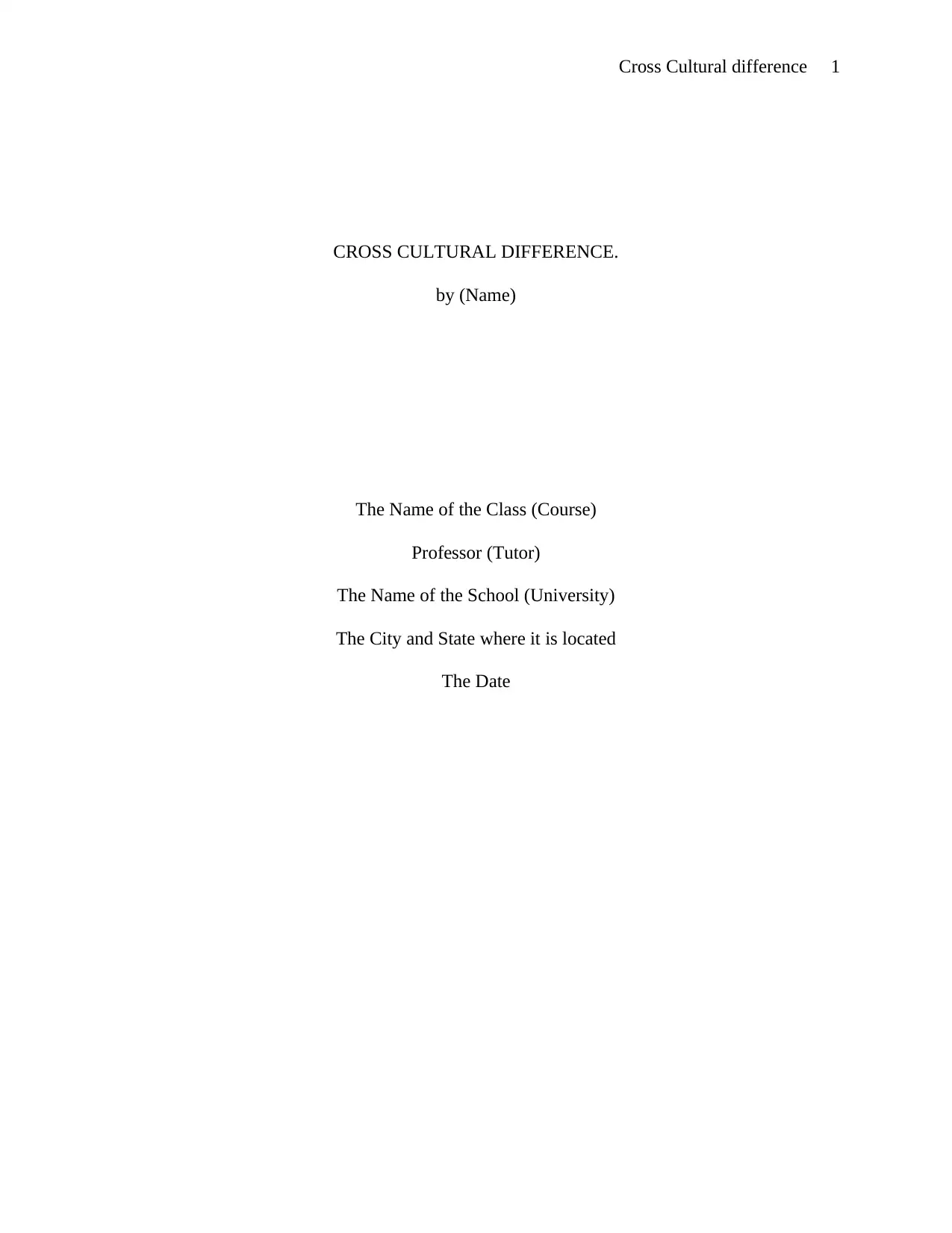
Cross Cultural difference 1
CROSS CULTURAL DIFFERENCE.
by (Name)
The Name of the Class (Course)
Professor (Tutor)
The Name of the School (University)
The City and State where it is located
The Date
CROSS CULTURAL DIFFERENCE.
by (Name)
The Name of the Class (Course)
Professor (Tutor)
The Name of the School (University)
The City and State where it is located
The Date
Paraphrase This Document
Need a fresh take? Get an instant paraphrase of this document with our AI Paraphraser
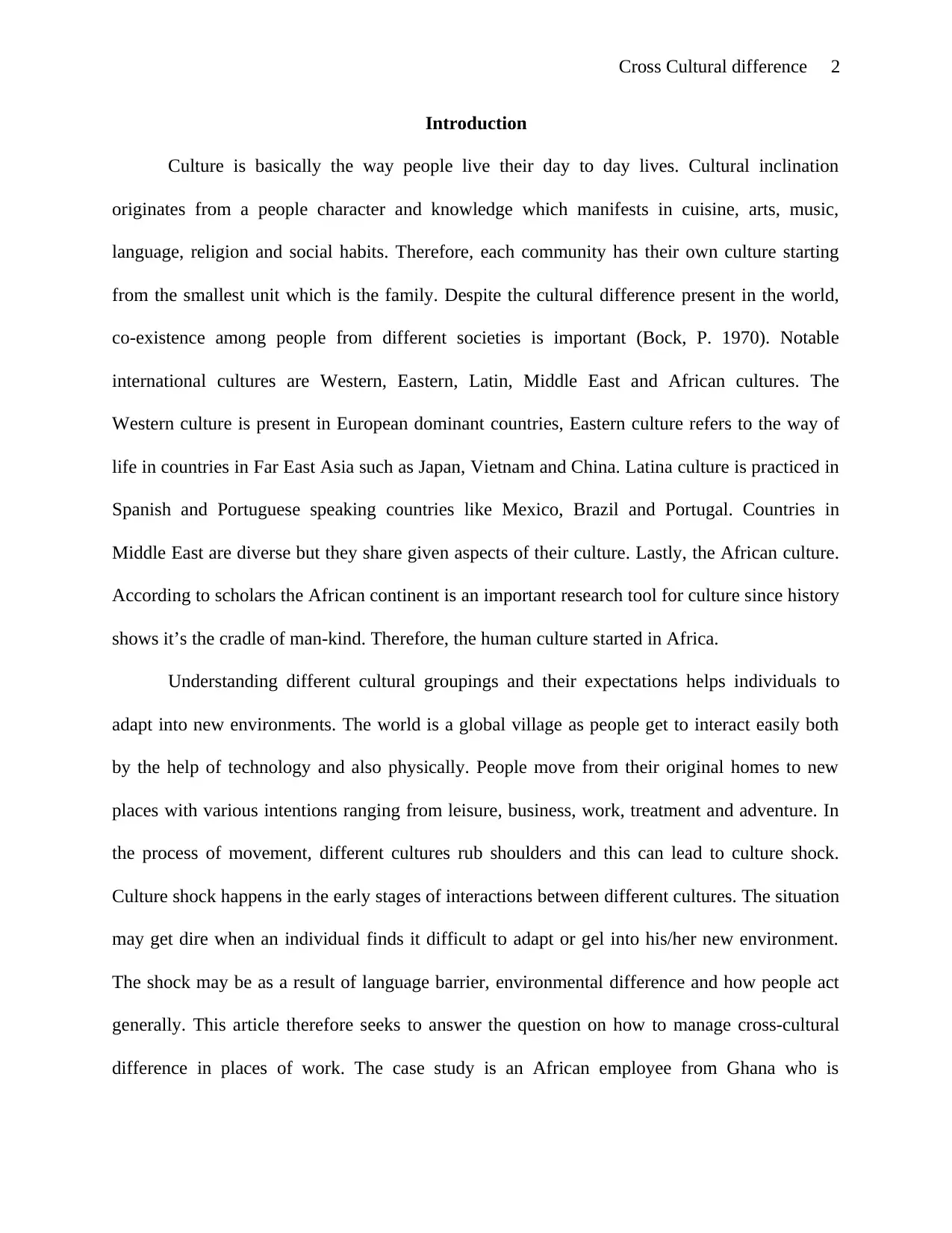
Cross Cultural difference 2
Introduction
Culture is basically the way people live their day to day lives. Cultural inclination
originates from a people character and knowledge which manifests in cuisine, arts, music,
language, religion and social habits. Therefore, each community has their own culture starting
from the smallest unit which is the family. Despite the cultural difference present in the world,
co-existence among people from different societies is important (Bock, P. 1970). Notable
international cultures are Western, Eastern, Latin, Middle East and African cultures. The
Western culture is present in European dominant countries, Eastern culture refers to the way of
life in countries in Far East Asia such as Japan, Vietnam and China. Latina culture is practiced in
Spanish and Portuguese speaking countries like Mexico, Brazil and Portugal. Countries in
Middle East are diverse but they share given aspects of their culture. Lastly, the African culture.
According to scholars the African continent is an important research tool for culture since history
shows it’s the cradle of man-kind. Therefore, the human culture started in Africa.
Understanding different cultural groupings and their expectations helps individuals to
adapt into new environments. The world is a global village as people get to interact easily both
by the help of technology and also physically. People move from their original homes to new
places with various intentions ranging from leisure, business, work, treatment and adventure. In
the process of movement, different cultures rub shoulders and this can lead to culture shock.
Culture shock happens in the early stages of interactions between different cultures. The situation
may get dire when an individual finds it difficult to adapt or gel into his/her new environment.
The shock may be as a result of language barrier, environmental difference and how people act
generally. This article therefore seeks to answer the question on how to manage cross-cultural
difference in places of work. The case study is an African employee from Ghana who is
Introduction
Culture is basically the way people live their day to day lives. Cultural inclination
originates from a people character and knowledge which manifests in cuisine, arts, music,
language, religion and social habits. Therefore, each community has their own culture starting
from the smallest unit which is the family. Despite the cultural difference present in the world,
co-existence among people from different societies is important (Bock, P. 1970). Notable
international cultures are Western, Eastern, Latin, Middle East and African cultures. The
Western culture is present in European dominant countries, Eastern culture refers to the way of
life in countries in Far East Asia such as Japan, Vietnam and China. Latina culture is practiced in
Spanish and Portuguese speaking countries like Mexico, Brazil and Portugal. Countries in
Middle East are diverse but they share given aspects of their culture. Lastly, the African culture.
According to scholars the African continent is an important research tool for culture since history
shows it’s the cradle of man-kind. Therefore, the human culture started in Africa.
Understanding different cultural groupings and their expectations helps individuals to
adapt into new environments. The world is a global village as people get to interact easily both
by the help of technology and also physically. People move from their original homes to new
places with various intentions ranging from leisure, business, work, treatment and adventure. In
the process of movement, different cultures rub shoulders and this can lead to culture shock.
Culture shock happens in the early stages of interactions between different cultures. The situation
may get dire when an individual finds it difficult to adapt or gel into his/her new environment.
The shock may be as a result of language barrier, environmental difference and how people act
generally. This article therefore seeks to answer the question on how to manage cross-cultural
difference in places of work. The case study is an African employee from Ghana who is
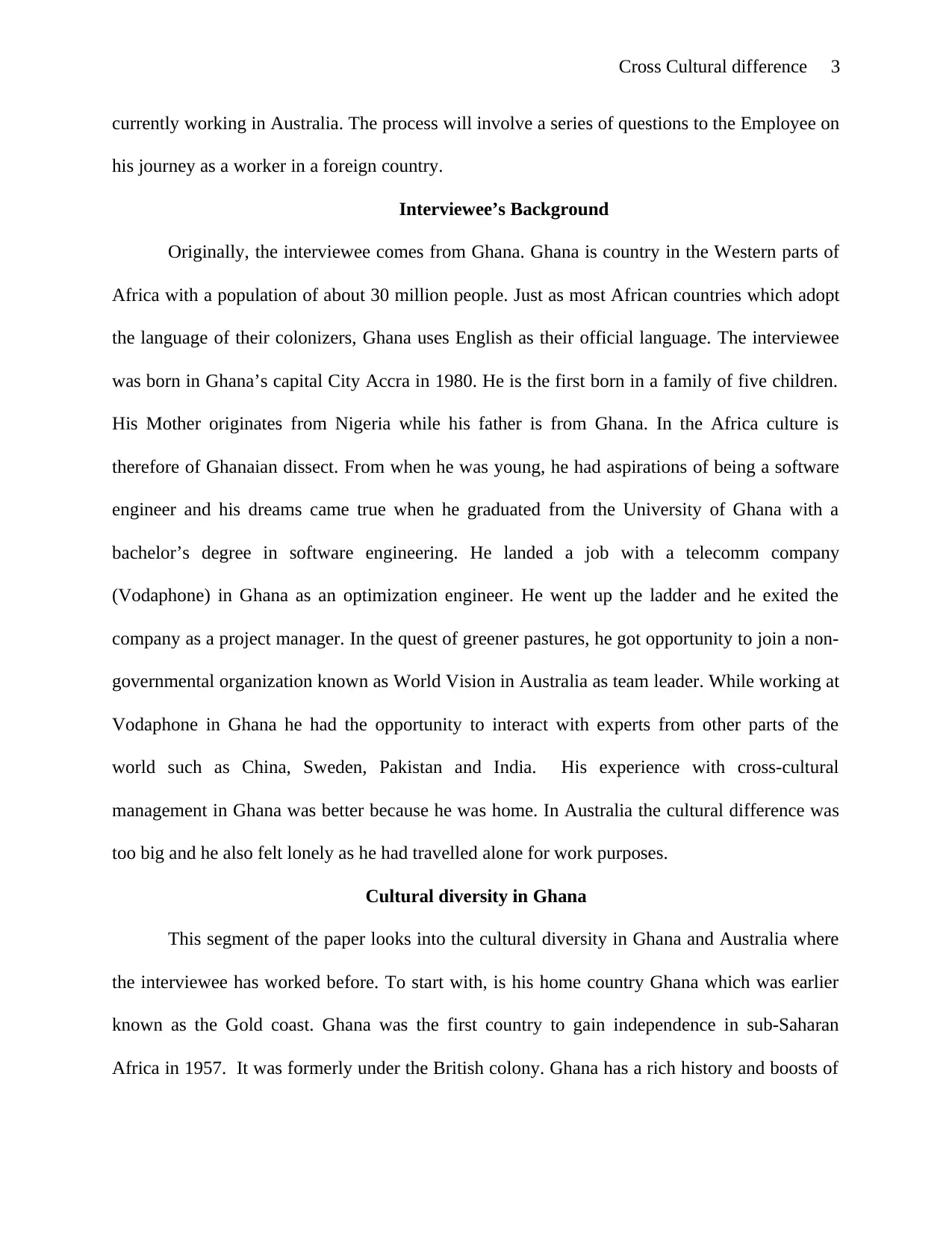
Cross Cultural difference 3
currently working in Australia. The process will involve a series of questions to the Employee on
his journey as a worker in a foreign country.
Interviewee’s Background
Originally, the interviewee comes from Ghana. Ghana is country in the Western parts of
Africa with a population of about 30 million people. Just as most African countries which adopt
the language of their colonizers, Ghana uses English as their official language. The interviewee
was born in Ghana’s capital City Accra in 1980. He is the first born in a family of five children.
His Mother originates from Nigeria while his father is from Ghana. In the Africa culture is
therefore of Ghanaian dissect. From when he was young, he had aspirations of being a software
engineer and his dreams came true when he graduated from the University of Ghana with a
bachelor’s degree in software engineering. He landed a job with a telecomm company
(Vodaphone) in Ghana as an optimization engineer. He went up the ladder and he exited the
company as a project manager. In the quest of greener pastures, he got opportunity to join a non-
governmental organization known as World Vision in Australia as team leader. While working at
Vodaphone in Ghana he had the opportunity to interact with experts from other parts of the
world such as China, Sweden, Pakistan and India. His experience with cross-cultural
management in Ghana was better because he was home. In Australia the cultural difference was
too big and he also felt lonely as he had travelled alone for work purposes.
Cultural diversity in Ghana
This segment of the paper looks into the cultural diversity in Ghana and Australia where
the interviewee has worked before. To start with, is his home country Ghana which was earlier
known as the Gold coast. Ghana was the first country to gain independence in sub-Saharan
Africa in 1957. It was formerly under the British colony. Ghana has a rich history and boosts of
currently working in Australia. The process will involve a series of questions to the Employee on
his journey as a worker in a foreign country.
Interviewee’s Background
Originally, the interviewee comes from Ghana. Ghana is country in the Western parts of
Africa with a population of about 30 million people. Just as most African countries which adopt
the language of their colonizers, Ghana uses English as their official language. The interviewee
was born in Ghana’s capital City Accra in 1980. He is the first born in a family of five children.
His Mother originates from Nigeria while his father is from Ghana. In the Africa culture is
therefore of Ghanaian dissect. From when he was young, he had aspirations of being a software
engineer and his dreams came true when he graduated from the University of Ghana with a
bachelor’s degree in software engineering. He landed a job with a telecomm company
(Vodaphone) in Ghana as an optimization engineer. He went up the ladder and he exited the
company as a project manager. In the quest of greener pastures, he got opportunity to join a non-
governmental organization known as World Vision in Australia as team leader. While working at
Vodaphone in Ghana he had the opportunity to interact with experts from other parts of the
world such as China, Sweden, Pakistan and India. His experience with cross-cultural
management in Ghana was better because he was home. In Australia the cultural difference was
too big and he also felt lonely as he had travelled alone for work purposes.
Cultural diversity in Ghana
This segment of the paper looks into the cultural diversity in Ghana and Australia where
the interviewee has worked before. To start with, is his home country Ghana which was earlier
known as the Gold coast. Ghana was the first country to gain independence in sub-Saharan
Africa in 1957. It was formerly under the British colony. Ghana has a rich history and boosts of
⊘ This is a preview!⊘
Do you want full access?
Subscribe today to unlock all pages.

Trusted by 1+ million students worldwide
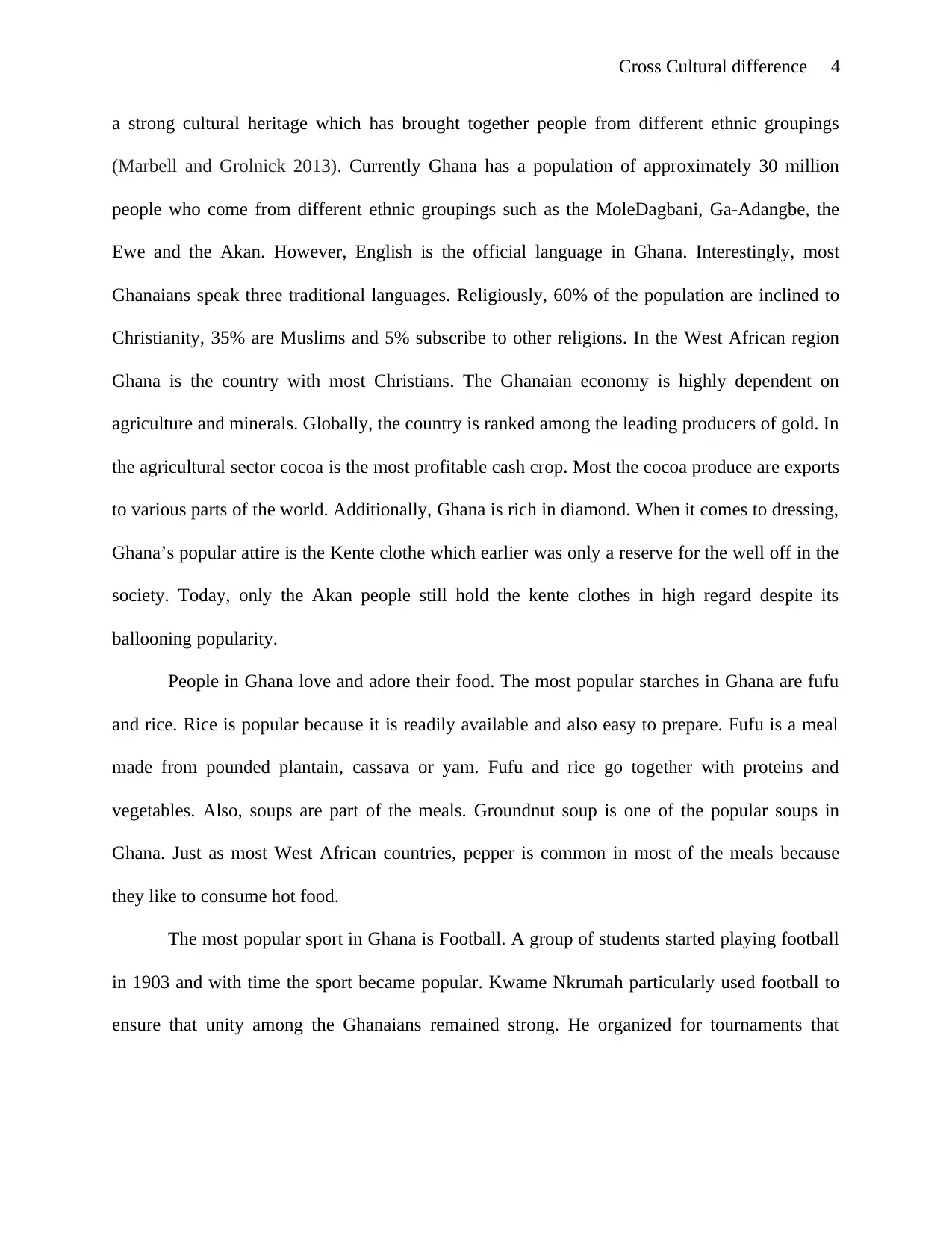
Cross Cultural difference 4
a strong cultural heritage which has brought together people from different ethnic groupings
(Marbell and Grolnick 2013). Currently Ghana has a population of approximately 30 million
people who come from different ethnic groupings such as the MoleDagbani, Ga-Adangbe, the
Ewe and the Akan. However, English is the official language in Ghana. Interestingly, most
Ghanaians speak three traditional languages. Religiously, 60% of the population are inclined to
Christianity, 35% are Muslims and 5% subscribe to other religions. In the West African region
Ghana is the country with most Christians. The Ghanaian economy is highly dependent on
agriculture and minerals. Globally, the country is ranked among the leading producers of gold. In
the agricultural sector cocoa is the most profitable cash crop. Most the cocoa produce are exports
to various parts of the world. Additionally, Ghana is rich in diamond. When it comes to dressing,
Ghana’s popular attire is the Kente clothe which earlier was only a reserve for the well off in the
society. Today, only the Akan people still hold the kente clothes in high regard despite its
ballooning popularity.
People in Ghana love and adore their food. The most popular starches in Ghana are fufu
and rice. Rice is popular because it is readily available and also easy to prepare. Fufu is a meal
made from pounded plantain, cassava or yam. Fufu and rice go together with proteins and
vegetables. Also, soups are part of the meals. Groundnut soup is one of the popular soups in
Ghana. Just as most West African countries, pepper is common in most of the meals because
they like to consume hot food.
The most popular sport in Ghana is Football. A group of students started playing football
in 1903 and with time the sport became popular. Kwame Nkrumah particularly used football to
ensure that unity among the Ghanaians remained strong. He organized for tournaments that
a strong cultural heritage which has brought together people from different ethnic groupings
(Marbell and Grolnick 2013). Currently Ghana has a population of approximately 30 million
people who come from different ethnic groupings such as the MoleDagbani, Ga-Adangbe, the
Ewe and the Akan. However, English is the official language in Ghana. Interestingly, most
Ghanaians speak three traditional languages. Religiously, 60% of the population are inclined to
Christianity, 35% are Muslims and 5% subscribe to other religions. In the West African region
Ghana is the country with most Christians. The Ghanaian economy is highly dependent on
agriculture and minerals. Globally, the country is ranked among the leading producers of gold. In
the agricultural sector cocoa is the most profitable cash crop. Most the cocoa produce are exports
to various parts of the world. Additionally, Ghana is rich in diamond. When it comes to dressing,
Ghana’s popular attire is the Kente clothe which earlier was only a reserve for the well off in the
society. Today, only the Akan people still hold the kente clothes in high regard despite its
ballooning popularity.
People in Ghana love and adore their food. The most popular starches in Ghana are fufu
and rice. Rice is popular because it is readily available and also easy to prepare. Fufu is a meal
made from pounded plantain, cassava or yam. Fufu and rice go together with proteins and
vegetables. Also, soups are part of the meals. Groundnut soup is one of the popular soups in
Ghana. Just as most West African countries, pepper is common in most of the meals because
they like to consume hot food.
The most popular sport in Ghana is Football. A group of students started playing football
in 1903 and with time the sport became popular. Kwame Nkrumah particularly used football to
ensure that unity among the Ghanaians remained strong. He organized for tournaments that
Paraphrase This Document
Need a fresh take? Get an instant paraphrase of this document with our AI Paraphraser
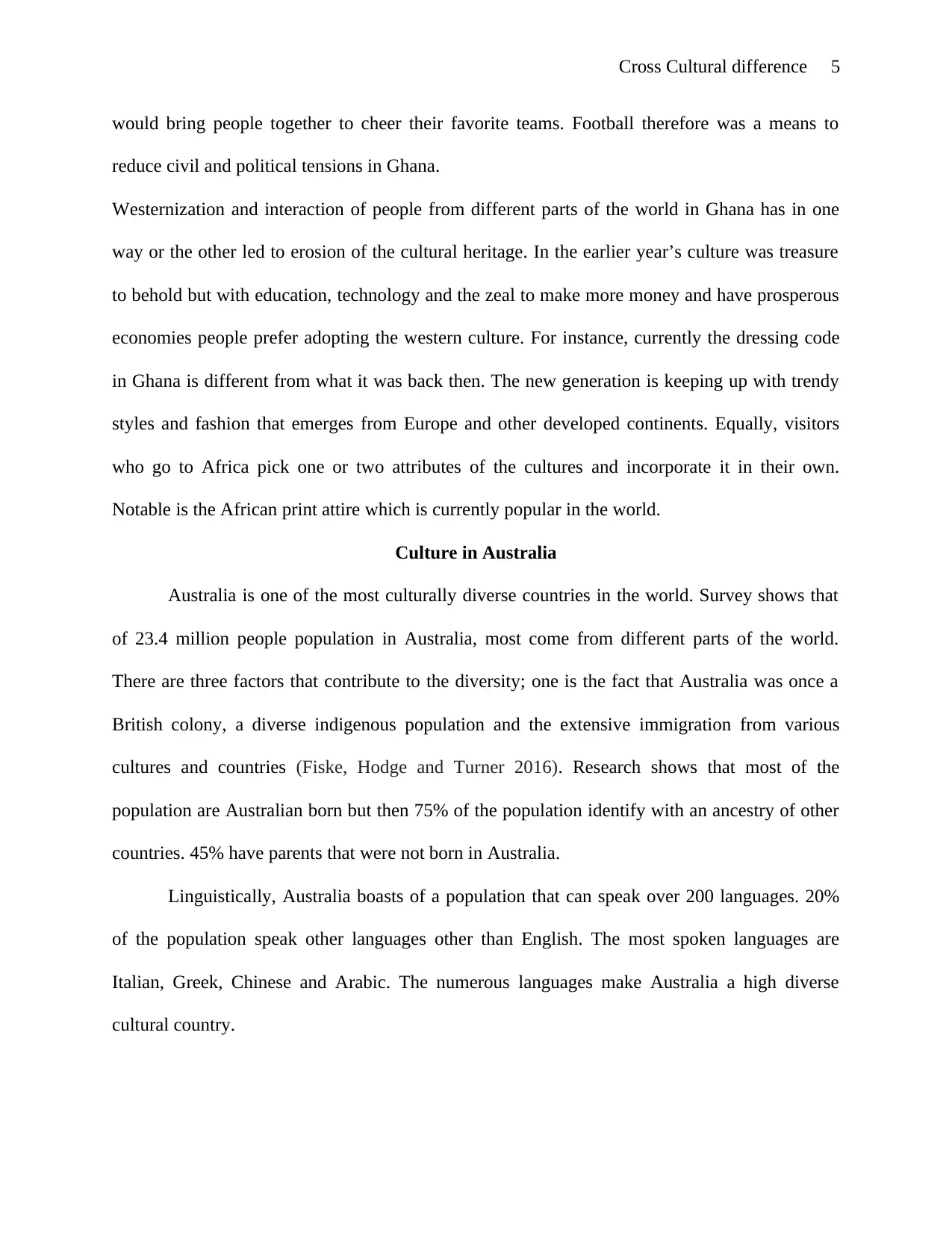
Cross Cultural difference 5
would bring people together to cheer their favorite teams. Football therefore was a means to
reduce civil and political tensions in Ghana.
Westernization and interaction of people from different parts of the world in Ghana has in one
way or the other led to erosion of the cultural heritage. In the earlier year’s culture was treasure
to behold but with education, technology and the zeal to make more money and have prosperous
economies people prefer adopting the western culture. For instance, currently the dressing code
in Ghana is different from what it was back then. The new generation is keeping up with trendy
styles and fashion that emerges from Europe and other developed continents. Equally, visitors
who go to Africa pick one or two attributes of the cultures and incorporate it in their own.
Notable is the African print attire which is currently popular in the world.
Culture in Australia
Australia is one of the most culturally diverse countries in the world. Survey shows that
of 23.4 million people population in Australia, most come from different parts of the world.
There are three factors that contribute to the diversity; one is the fact that Australia was once a
British colony, a diverse indigenous population and the extensive immigration from various
cultures and countries (Fiske, Hodge and Turner 2016). Research shows that most of the
population are Australian born but then 75% of the population identify with an ancestry of other
countries. 45% have parents that were not born in Australia.
Linguistically, Australia boasts of a population that can speak over 200 languages. 20%
of the population speak other languages other than English. The most spoken languages are
Italian, Greek, Chinese and Arabic. The numerous languages make Australia a high diverse
cultural country.
would bring people together to cheer their favorite teams. Football therefore was a means to
reduce civil and political tensions in Ghana.
Westernization and interaction of people from different parts of the world in Ghana has in one
way or the other led to erosion of the cultural heritage. In the earlier year’s culture was treasure
to behold but with education, technology and the zeal to make more money and have prosperous
economies people prefer adopting the western culture. For instance, currently the dressing code
in Ghana is different from what it was back then. The new generation is keeping up with trendy
styles and fashion that emerges from Europe and other developed continents. Equally, visitors
who go to Africa pick one or two attributes of the cultures and incorporate it in their own.
Notable is the African print attire which is currently popular in the world.
Culture in Australia
Australia is one of the most culturally diverse countries in the world. Survey shows that
of 23.4 million people population in Australia, most come from different parts of the world.
There are three factors that contribute to the diversity; one is the fact that Australia was once a
British colony, a diverse indigenous population and the extensive immigration from various
cultures and countries (Fiske, Hodge and Turner 2016). Research shows that most of the
population are Australian born but then 75% of the population identify with an ancestry of other
countries. 45% have parents that were not born in Australia.
Linguistically, Australia boasts of a population that can speak over 200 languages. 20%
of the population speak other languages other than English. The most spoken languages are
Italian, Greek, Chinese and Arabic. The numerous languages make Australia a high diverse
cultural country.
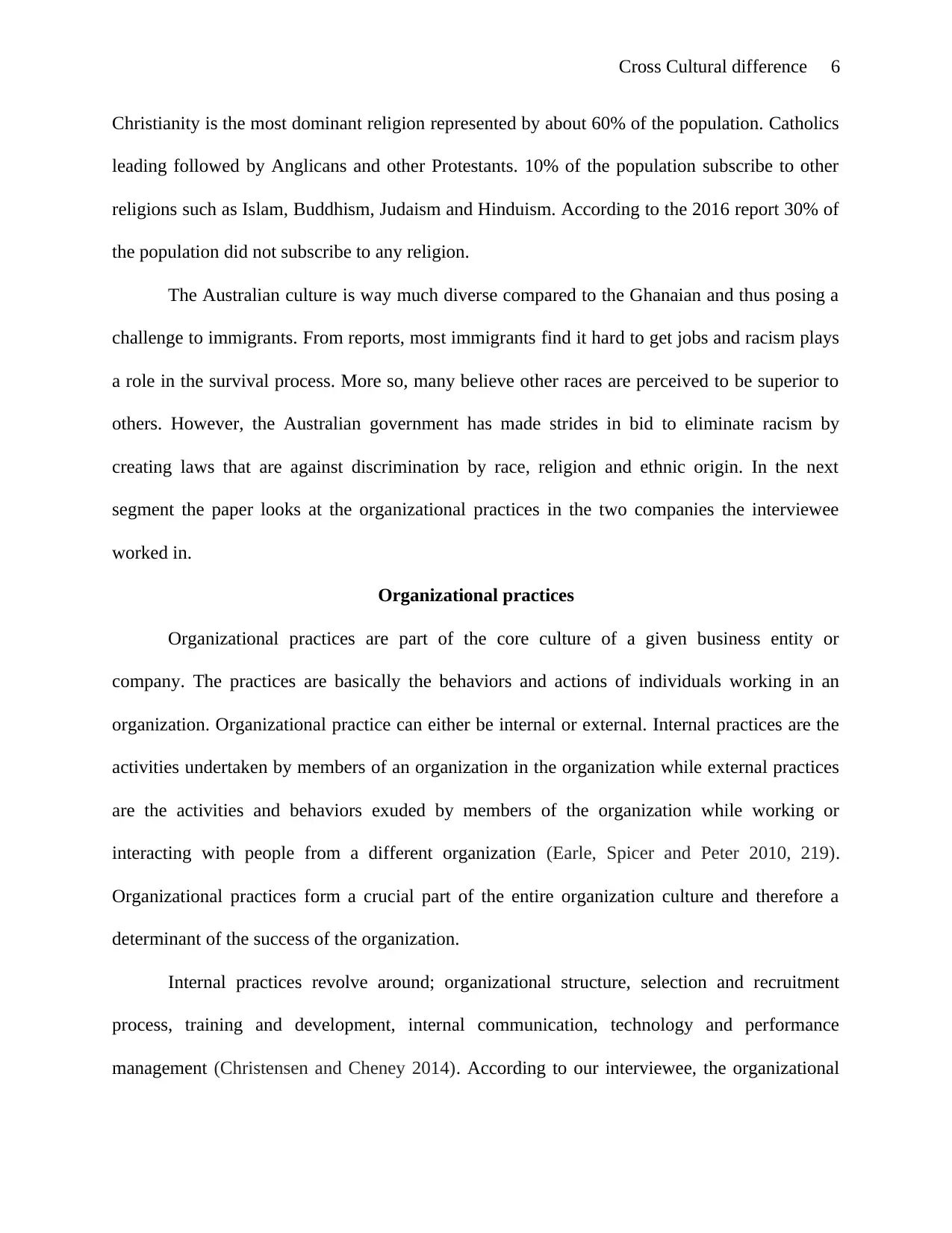
Cross Cultural difference 6
Christianity is the most dominant religion represented by about 60% of the population. Catholics
leading followed by Anglicans and other Protestants. 10% of the population subscribe to other
religions such as Islam, Buddhism, Judaism and Hinduism. According to the 2016 report 30% of
the population did not subscribe to any religion.
The Australian culture is way much diverse compared to the Ghanaian and thus posing a
challenge to immigrants. From reports, most immigrants find it hard to get jobs and racism plays
a role in the survival process. More so, many believe other races are perceived to be superior to
others. However, the Australian government has made strides in bid to eliminate racism by
creating laws that are against discrimination by race, religion and ethnic origin. In the next
segment the paper looks at the organizational practices in the two companies the interviewee
worked in.
Organizational practices
Organizational practices are part of the core culture of a given business entity or
company. The practices are basically the behaviors and actions of individuals working in an
organization. Organizational practice can either be internal or external. Internal practices are the
activities undertaken by members of an organization in the organization while external practices
are the activities and behaviors exuded by members of the organization while working or
interacting with people from a different organization (Earle, Spicer and Peter 2010, 219).
Organizational practices form a crucial part of the entire organization culture and therefore a
determinant of the success of the organization.
Internal practices revolve around; organizational structure, selection and recruitment
process, training and development, internal communication, technology and performance
management (Christensen and Cheney 2014). According to our interviewee, the organizational
Christianity is the most dominant religion represented by about 60% of the population. Catholics
leading followed by Anglicans and other Protestants. 10% of the population subscribe to other
religions such as Islam, Buddhism, Judaism and Hinduism. According to the 2016 report 30% of
the population did not subscribe to any religion.
The Australian culture is way much diverse compared to the Ghanaian and thus posing a
challenge to immigrants. From reports, most immigrants find it hard to get jobs and racism plays
a role in the survival process. More so, many believe other races are perceived to be superior to
others. However, the Australian government has made strides in bid to eliminate racism by
creating laws that are against discrimination by race, religion and ethnic origin. In the next
segment the paper looks at the organizational practices in the two companies the interviewee
worked in.
Organizational practices
Organizational practices are part of the core culture of a given business entity or
company. The practices are basically the behaviors and actions of individuals working in an
organization. Organizational practice can either be internal or external. Internal practices are the
activities undertaken by members of an organization in the organization while external practices
are the activities and behaviors exuded by members of the organization while working or
interacting with people from a different organization (Earle, Spicer and Peter 2010, 219).
Organizational practices form a crucial part of the entire organization culture and therefore a
determinant of the success of the organization.
Internal practices revolve around; organizational structure, selection and recruitment
process, training and development, internal communication, technology and performance
management (Christensen and Cheney 2014). According to our interviewee, the organizational
⊘ This is a preview!⊘
Do you want full access?
Subscribe today to unlock all pages.

Trusted by 1+ million students worldwide
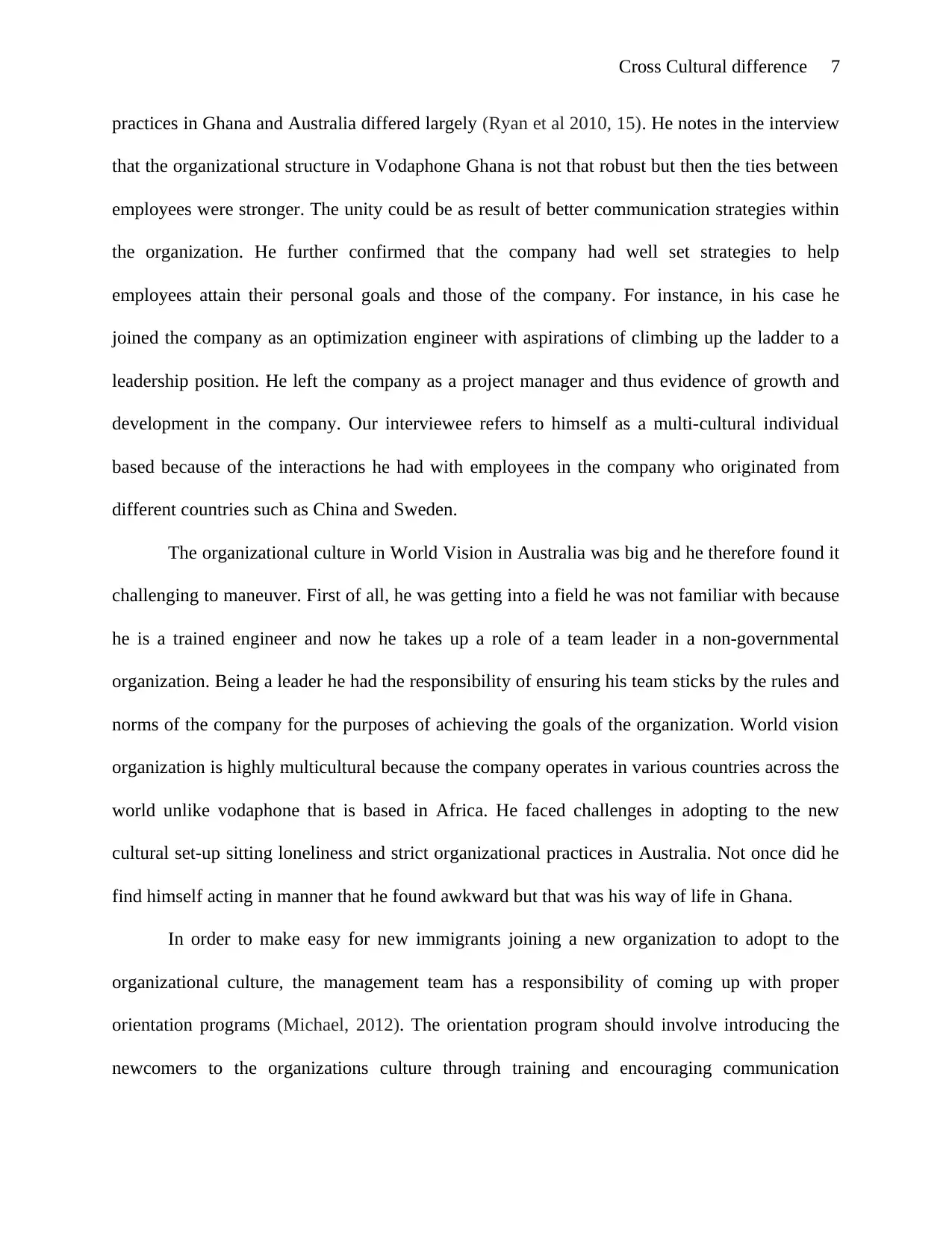
Cross Cultural difference 7
practices in Ghana and Australia differed largely (Ryan et al 2010, 15). He notes in the interview
that the organizational structure in Vodaphone Ghana is not that robust but then the ties between
employees were stronger. The unity could be as result of better communication strategies within
the organization. He further confirmed that the company had well set strategies to help
employees attain their personal goals and those of the company. For instance, in his case he
joined the company as an optimization engineer with aspirations of climbing up the ladder to a
leadership position. He left the company as a project manager and thus evidence of growth and
development in the company. Our interviewee refers to himself as a multi-cultural individual
based because of the interactions he had with employees in the company who originated from
different countries such as China and Sweden.
The organizational culture in World Vision in Australia was big and he therefore found it
challenging to maneuver. First of all, he was getting into a field he was not familiar with because
he is a trained engineer and now he takes up a role of a team leader in a non-governmental
organization. Being a leader he had the responsibility of ensuring his team sticks by the rules and
norms of the company for the purposes of achieving the goals of the organization. World vision
organization is highly multicultural because the company operates in various countries across the
world unlike vodaphone that is based in Africa. He faced challenges in adopting to the new
cultural set-up sitting loneliness and strict organizational practices in Australia. Not once did he
find himself acting in manner that he found awkward but that was his way of life in Ghana.
In order to make easy for new immigrants joining a new organization to adopt to the
organizational culture, the management team has a responsibility of coming up with proper
orientation programs (Michael, 2012). The orientation program should involve introducing the
newcomers to the organizations culture through training and encouraging communication
practices in Ghana and Australia differed largely (Ryan et al 2010, 15). He notes in the interview
that the organizational structure in Vodaphone Ghana is not that robust but then the ties between
employees were stronger. The unity could be as result of better communication strategies within
the organization. He further confirmed that the company had well set strategies to help
employees attain their personal goals and those of the company. For instance, in his case he
joined the company as an optimization engineer with aspirations of climbing up the ladder to a
leadership position. He left the company as a project manager and thus evidence of growth and
development in the company. Our interviewee refers to himself as a multi-cultural individual
based because of the interactions he had with employees in the company who originated from
different countries such as China and Sweden.
The organizational culture in World Vision in Australia was big and he therefore found it
challenging to maneuver. First of all, he was getting into a field he was not familiar with because
he is a trained engineer and now he takes up a role of a team leader in a non-governmental
organization. Being a leader he had the responsibility of ensuring his team sticks by the rules and
norms of the company for the purposes of achieving the goals of the organization. World vision
organization is highly multicultural because the company operates in various countries across the
world unlike vodaphone that is based in Africa. He faced challenges in adopting to the new
cultural set-up sitting loneliness and strict organizational practices in Australia. Not once did he
find himself acting in manner that he found awkward but that was his way of life in Ghana.
In order to make easy for new immigrants joining a new organization to adopt to the
organizational culture, the management team has a responsibility of coming up with proper
orientation programs (Michael, 2012). The orientation program should involve introducing the
newcomers to the organizations culture through training and encouraging communication
Paraphrase This Document
Need a fresh take? Get an instant paraphrase of this document with our AI Paraphraser
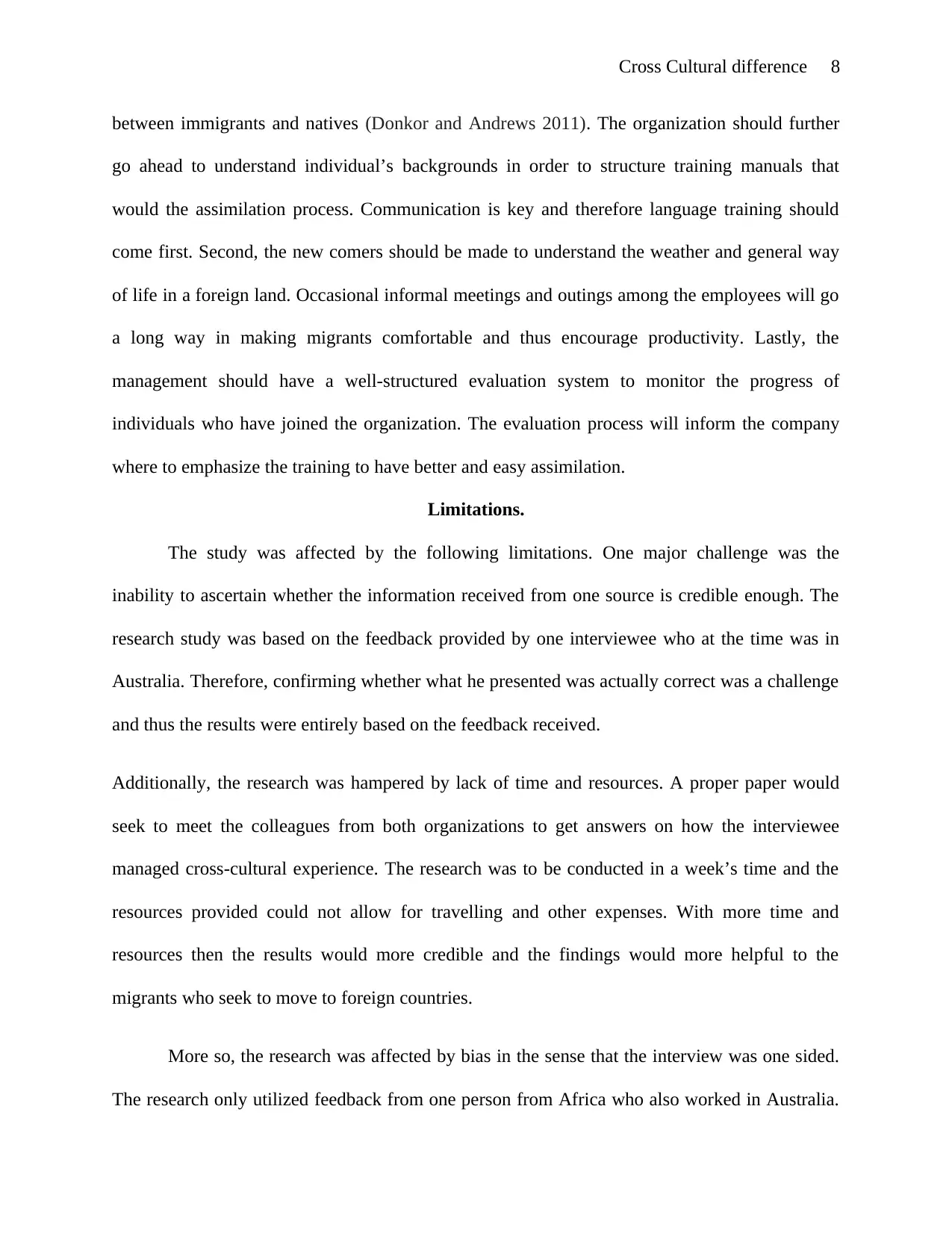
Cross Cultural difference 8
between immigrants and natives (Donkor and Andrews 2011). The organization should further
go ahead to understand individual’s backgrounds in order to structure training manuals that
would the assimilation process. Communication is key and therefore language training should
come first. Second, the new comers should be made to understand the weather and general way
of life in a foreign land. Occasional informal meetings and outings among the employees will go
a long way in making migrants comfortable and thus encourage productivity. Lastly, the
management should have a well-structured evaluation system to monitor the progress of
individuals who have joined the organization. The evaluation process will inform the company
where to emphasize the training to have better and easy assimilation.
Limitations.
The study was affected by the following limitations. One major challenge was the
inability to ascertain whether the information received from one source is credible enough. The
research study was based on the feedback provided by one interviewee who at the time was in
Australia. Therefore, confirming whether what he presented was actually correct was a challenge
and thus the results were entirely based on the feedback received.
Additionally, the research was hampered by lack of time and resources. A proper paper would
seek to meet the colleagues from both organizations to get answers on how the interviewee
managed cross-cultural experience. The research was to be conducted in a week’s time and the
resources provided could not allow for travelling and other expenses. With more time and
resources then the results would more credible and the findings would more helpful to the
migrants who seek to move to foreign countries.
More so, the research was affected by bias in the sense that the interview was one sided.
The research only utilized feedback from one person from Africa who also worked in Australia.
between immigrants and natives (Donkor and Andrews 2011). The organization should further
go ahead to understand individual’s backgrounds in order to structure training manuals that
would the assimilation process. Communication is key and therefore language training should
come first. Second, the new comers should be made to understand the weather and general way
of life in a foreign land. Occasional informal meetings and outings among the employees will go
a long way in making migrants comfortable and thus encourage productivity. Lastly, the
management should have a well-structured evaluation system to monitor the progress of
individuals who have joined the organization. The evaluation process will inform the company
where to emphasize the training to have better and easy assimilation.
Limitations.
The study was affected by the following limitations. One major challenge was the
inability to ascertain whether the information received from one source is credible enough. The
research study was based on the feedback provided by one interviewee who at the time was in
Australia. Therefore, confirming whether what he presented was actually correct was a challenge
and thus the results were entirely based on the feedback received.
Additionally, the research was hampered by lack of time and resources. A proper paper would
seek to meet the colleagues from both organizations to get answers on how the interviewee
managed cross-cultural experience. The research was to be conducted in a week’s time and the
resources provided could not allow for travelling and other expenses. With more time and
resources then the results would more credible and the findings would more helpful to the
migrants who seek to move to foreign countries.
More so, the research was affected by bias in the sense that the interview was one sided.
The research only utilized feedback from one person from Africa who also worked in Australia.
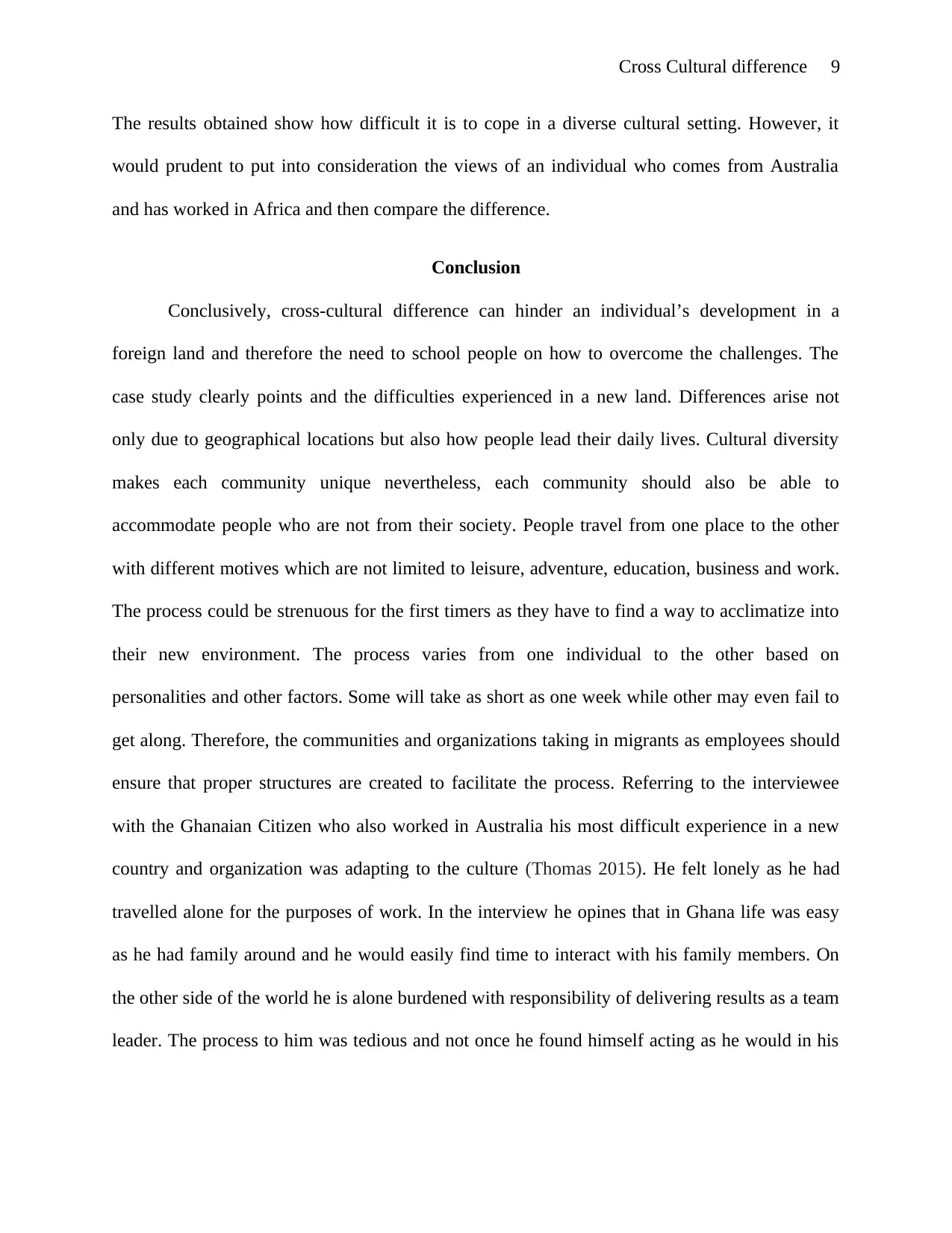
Cross Cultural difference 9
The results obtained show how difficult it is to cope in a diverse cultural setting. However, it
would prudent to put into consideration the views of an individual who comes from Australia
and has worked in Africa and then compare the difference.
Conclusion
Conclusively, cross-cultural difference can hinder an individual’s development in a
foreign land and therefore the need to school people on how to overcome the challenges. The
case study clearly points and the difficulties experienced in a new land. Differences arise not
only due to geographical locations but also how people lead their daily lives. Cultural diversity
makes each community unique nevertheless, each community should also be able to
accommodate people who are not from their society. People travel from one place to the other
with different motives which are not limited to leisure, adventure, education, business and work.
The process could be strenuous for the first timers as they have to find a way to acclimatize into
their new environment. The process varies from one individual to the other based on
personalities and other factors. Some will take as short as one week while other may even fail to
get along. Therefore, the communities and organizations taking in migrants as employees should
ensure that proper structures are created to facilitate the process. Referring to the interviewee
with the Ghanaian Citizen who also worked in Australia his most difficult experience in a new
country and organization was adapting to the culture (Thomas 2015). He felt lonely as he had
travelled alone for the purposes of work. In the interview he opines that in Ghana life was easy
as he had family around and he would easily find time to interact with his family members. On
the other side of the world he is alone burdened with responsibility of delivering results as a team
leader. The process to him was tedious and not once he found himself acting as he would in his
The results obtained show how difficult it is to cope in a diverse cultural setting. However, it
would prudent to put into consideration the views of an individual who comes from Australia
and has worked in Africa and then compare the difference.
Conclusion
Conclusively, cross-cultural difference can hinder an individual’s development in a
foreign land and therefore the need to school people on how to overcome the challenges. The
case study clearly points and the difficulties experienced in a new land. Differences arise not
only due to geographical locations but also how people lead their daily lives. Cultural diversity
makes each community unique nevertheless, each community should also be able to
accommodate people who are not from their society. People travel from one place to the other
with different motives which are not limited to leisure, adventure, education, business and work.
The process could be strenuous for the first timers as they have to find a way to acclimatize into
their new environment. The process varies from one individual to the other based on
personalities and other factors. Some will take as short as one week while other may even fail to
get along. Therefore, the communities and organizations taking in migrants as employees should
ensure that proper structures are created to facilitate the process. Referring to the interviewee
with the Ghanaian Citizen who also worked in Australia his most difficult experience in a new
country and organization was adapting to the culture (Thomas 2015). He felt lonely as he had
travelled alone for the purposes of work. In the interview he opines that in Ghana life was easy
as he had family around and he would easily find time to interact with his family members. On
the other side of the world he is alone burdened with responsibility of delivering results as a team
leader. The process to him was tedious and not once he found himself acting as he would in his
⊘ This is a preview!⊘
Do you want full access?
Subscribe today to unlock all pages.

Trusted by 1+ million students worldwide
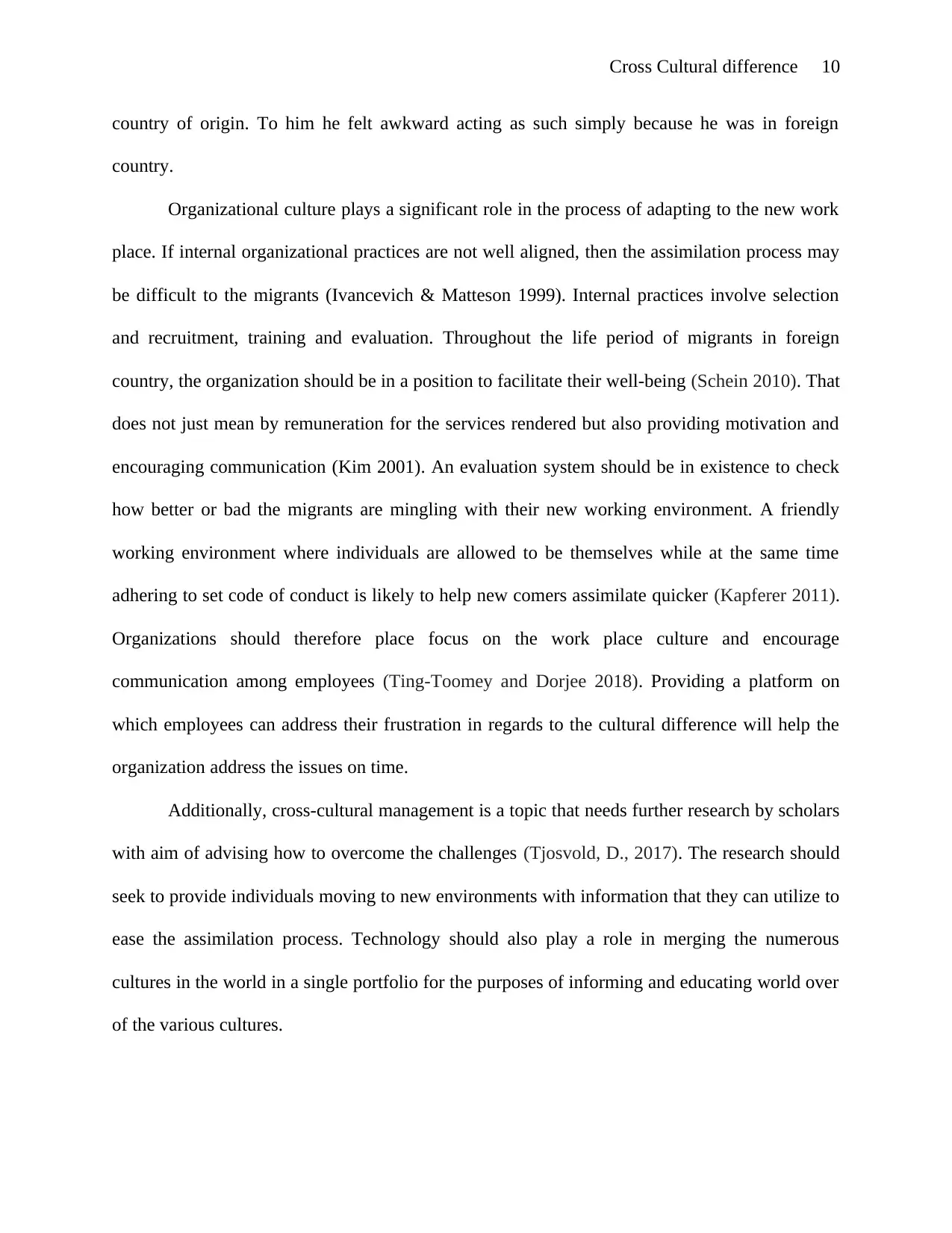
Cross Cultural difference 10
country of origin. To him he felt awkward acting as such simply because he was in foreign
country.
Organizational culture plays a significant role in the process of adapting to the new work
place. If internal organizational practices are not well aligned, then the assimilation process may
be difficult to the migrants (Ivancevich & Matteson 1999). Internal practices involve selection
and recruitment, training and evaluation. Throughout the life period of migrants in foreign
country, the organization should be in a position to facilitate their well-being (Schein 2010). That
does not just mean by remuneration for the services rendered but also providing motivation and
encouraging communication (Kim 2001). An evaluation system should be in existence to check
how better or bad the migrants are mingling with their new working environment. A friendly
working environment where individuals are allowed to be themselves while at the same time
adhering to set code of conduct is likely to help new comers assimilate quicker (Kapferer 2011).
Organizations should therefore place focus on the work place culture and encourage
communication among employees (Ting-Toomey and Dorjee 2018). Providing a platform on
which employees can address their frustration in regards to the cultural difference will help the
organization address the issues on time.
Additionally, cross-cultural management is a topic that needs further research by scholars
with aim of advising how to overcome the challenges (Tjosvold, D., 2017). The research should
seek to provide individuals moving to new environments with information that they can utilize to
ease the assimilation process. Technology should also play a role in merging the numerous
cultures in the world in a single portfolio for the purposes of informing and educating world over
of the various cultures.
country of origin. To him he felt awkward acting as such simply because he was in foreign
country.
Organizational culture plays a significant role in the process of adapting to the new work
place. If internal organizational practices are not well aligned, then the assimilation process may
be difficult to the migrants (Ivancevich & Matteson 1999). Internal practices involve selection
and recruitment, training and evaluation. Throughout the life period of migrants in foreign
country, the organization should be in a position to facilitate their well-being (Schein 2010). That
does not just mean by remuneration for the services rendered but also providing motivation and
encouraging communication (Kim 2001). An evaluation system should be in existence to check
how better or bad the migrants are mingling with their new working environment. A friendly
working environment where individuals are allowed to be themselves while at the same time
adhering to set code of conduct is likely to help new comers assimilate quicker (Kapferer 2011).
Organizations should therefore place focus on the work place culture and encourage
communication among employees (Ting-Toomey and Dorjee 2018). Providing a platform on
which employees can address their frustration in regards to the cultural difference will help the
organization address the issues on time.
Additionally, cross-cultural management is a topic that needs further research by scholars
with aim of advising how to overcome the challenges (Tjosvold, D., 2017). The research should
seek to provide individuals moving to new environments with information that they can utilize to
ease the assimilation process. Technology should also play a role in merging the numerous
cultures in the world in a single portfolio for the purposes of informing and educating world over
of the various cultures.
Paraphrase This Document
Need a fresh take? Get an instant paraphrase of this document with our AI Paraphraser
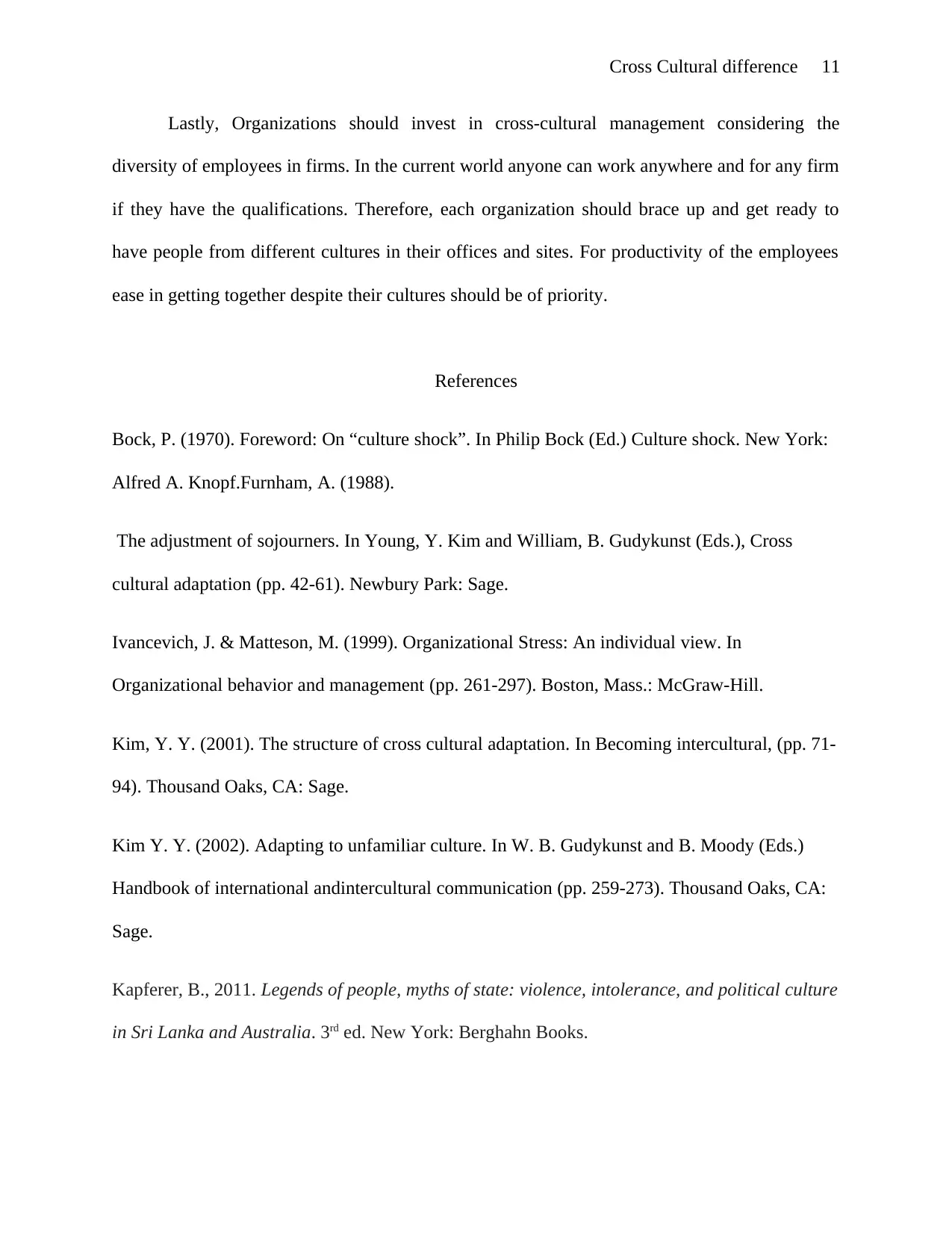
Cross Cultural difference 11
Lastly, Organizations should invest in cross-cultural management considering the
diversity of employees in firms. In the current world anyone can work anywhere and for any firm
if they have the qualifications. Therefore, each organization should brace up and get ready to
have people from different cultures in their offices and sites. For productivity of the employees
ease in getting together despite their cultures should be of priority.
References
Bock, P. (1970). Foreword: On “culture shock”. In Philip Bock (Ed.) Culture shock. New York:
Alfred A. Knopf.Furnham, A. (1988).
The adjustment of sojourners. In Young, Y. Kim and William, B. Gudykunst (Eds.), Cross
cultural adaptation (pp. 42-61). Newbury Park: Sage.
Ivancevich, J. & Matteson, M. (1999). Organizational Stress: An individual view. In
Organizational behavior and management (pp. 261-297). Boston, Mass.: McGraw-Hill.
Kim, Y. Y. (2001). The structure of cross cultural adaptation. In Becoming intercultural, (pp. 71-
94). Thousand Oaks, CA: Sage.
Kim Y. Y. (2002). Adapting to unfamiliar culture. In W. B. Gudykunst and B. Moody (Eds.)
Handbook of international andintercultural communication (pp. 259-273). Thousand Oaks, CA:
Sage.
Kapferer, B., 2011. Legends of people, myths of state: violence, intolerance, and political culture
in Sri Lanka and Australia. 3rd ed. New York: Berghahn Books.
Lastly, Organizations should invest in cross-cultural management considering the
diversity of employees in firms. In the current world anyone can work anywhere and for any firm
if they have the qualifications. Therefore, each organization should brace up and get ready to
have people from different cultures in their offices and sites. For productivity of the employees
ease in getting together despite their cultures should be of priority.
References
Bock, P. (1970). Foreword: On “culture shock”. In Philip Bock (Ed.) Culture shock. New York:
Alfred A. Knopf.Furnham, A. (1988).
The adjustment of sojourners. In Young, Y. Kim and William, B. Gudykunst (Eds.), Cross
cultural adaptation (pp. 42-61). Newbury Park: Sage.
Ivancevich, J. & Matteson, M. (1999). Organizational Stress: An individual view. In
Organizational behavior and management (pp. 261-297). Boston, Mass.: McGraw-Hill.
Kim, Y. Y. (2001). The structure of cross cultural adaptation. In Becoming intercultural, (pp. 71-
94). Thousand Oaks, CA: Sage.
Kim Y. Y. (2002). Adapting to unfamiliar culture. In W. B. Gudykunst and B. Moody (Eds.)
Handbook of international andintercultural communication (pp. 259-273). Thousand Oaks, CA:
Sage.
Kapferer, B., 2011. Legends of people, myths of state: violence, intolerance, and political culture
in Sri Lanka and Australia. 3rd ed. New York: Berghahn Books.
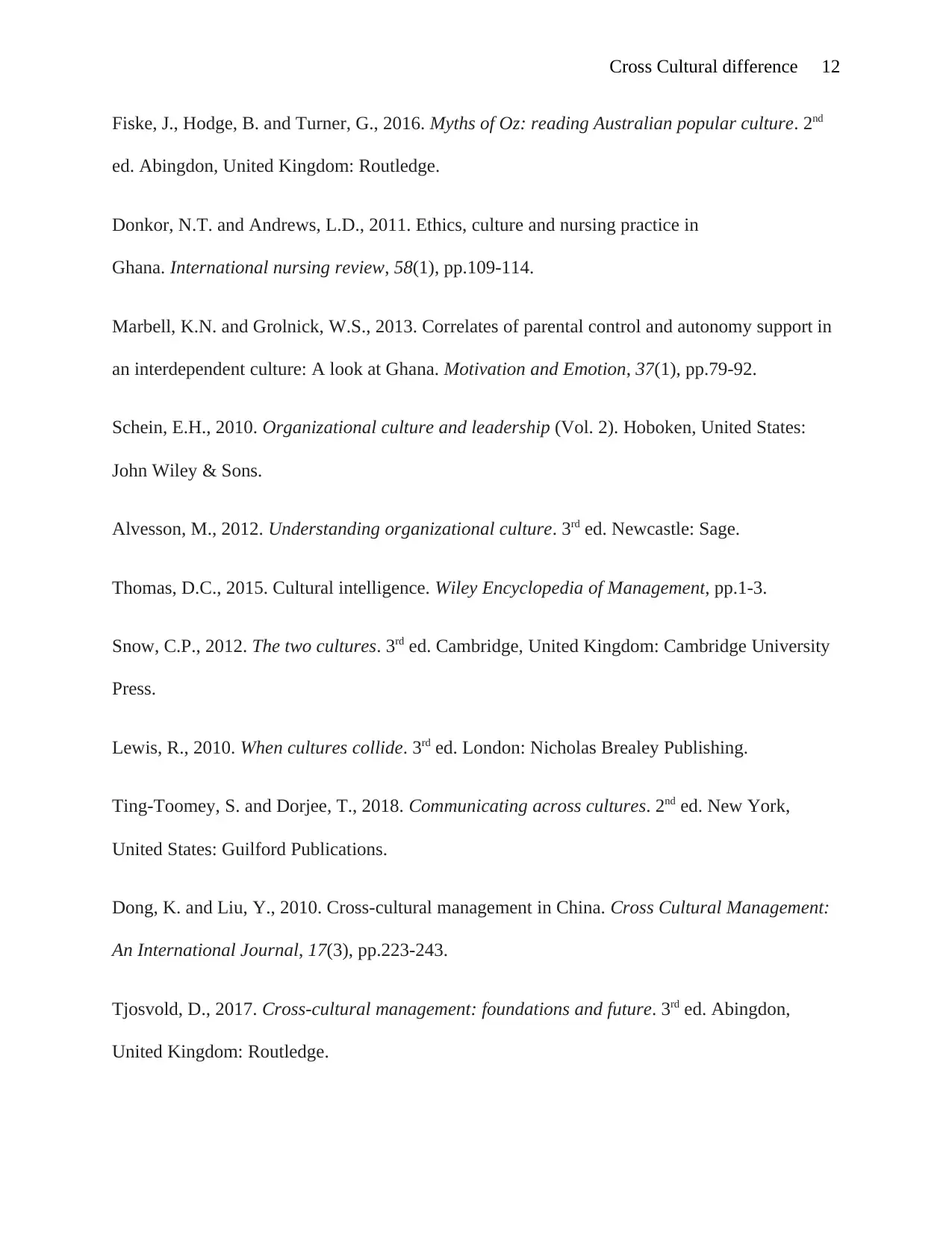
Cross Cultural difference 12
Fiske, J., Hodge, B. and Turner, G., 2016. Myths of Oz: reading Australian popular culture. 2nd
ed. Abingdon, United Kingdom: Routledge.
Donkor, N.T. and Andrews, L.D., 2011. Ethics, culture and nursing practice in
Ghana. International nursing review, 58(1), pp.109-114.
Marbell, K.N. and Grolnick, W.S., 2013. Correlates of parental control and autonomy support in
an interdependent culture: A look at Ghana. Motivation and Emotion, 37(1), pp.79-92.
Schein, E.H., 2010. Organizational culture and leadership (Vol. 2). Hoboken, United States:
John Wiley & Sons.
Alvesson, M., 2012. Understanding organizational culture. 3rd ed. Newcastle: Sage.
Thomas, D.C., 2015. Cultural intelligence. Wiley Encyclopedia of Management, pp.1-3.
Snow, C.P., 2012. The two cultures. 3rd ed. Cambridge, United Kingdom: Cambridge University
Press.
Lewis, R., 2010. When cultures collide. 3rd ed. London: Nicholas Brealey Publishing.
Ting-Toomey, S. and Dorjee, T., 2018. Communicating across cultures. 2nd ed. New York,
United States: Guilford Publications.
Dong, K. and Liu, Y., 2010. Cross-cultural management in China. Cross Cultural Management:
An International Journal, 17(3), pp.223-243.
Tjosvold, D., 2017. Cross-cultural management: foundations and future. 3rd ed. Abingdon,
United Kingdom: Routledge.
Fiske, J., Hodge, B. and Turner, G., 2016. Myths of Oz: reading Australian popular culture. 2nd
ed. Abingdon, United Kingdom: Routledge.
Donkor, N.T. and Andrews, L.D., 2011. Ethics, culture and nursing practice in
Ghana. International nursing review, 58(1), pp.109-114.
Marbell, K.N. and Grolnick, W.S., 2013. Correlates of parental control and autonomy support in
an interdependent culture: A look at Ghana. Motivation and Emotion, 37(1), pp.79-92.
Schein, E.H., 2010. Organizational culture and leadership (Vol. 2). Hoboken, United States:
John Wiley & Sons.
Alvesson, M., 2012. Understanding organizational culture. 3rd ed. Newcastle: Sage.
Thomas, D.C., 2015. Cultural intelligence. Wiley Encyclopedia of Management, pp.1-3.
Snow, C.P., 2012. The two cultures. 3rd ed. Cambridge, United Kingdom: Cambridge University
Press.
Lewis, R., 2010. When cultures collide. 3rd ed. London: Nicholas Brealey Publishing.
Ting-Toomey, S. and Dorjee, T., 2018. Communicating across cultures. 2nd ed. New York,
United States: Guilford Publications.
Dong, K. and Liu, Y., 2010. Cross-cultural management in China. Cross Cultural Management:
An International Journal, 17(3), pp.223-243.
Tjosvold, D., 2017. Cross-cultural management: foundations and future. 3rd ed. Abingdon,
United Kingdom: Routledge.
⊘ This is a preview!⊘
Do you want full access?
Subscribe today to unlock all pages.

Trusted by 1+ million students worldwide
1 out of 13
Related Documents
Your All-in-One AI-Powered Toolkit for Academic Success.
+13062052269
info@desklib.com
Available 24*7 on WhatsApp / Email
![[object Object]](/_next/static/media/star-bottom.7253800d.svg)
Unlock your academic potential
Copyright © 2020–2025 A2Z Services. All Rights Reserved. Developed and managed by ZUCOL.





